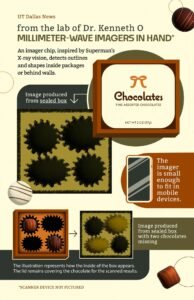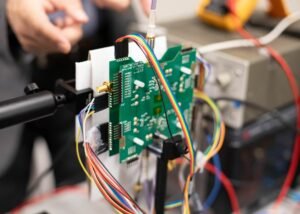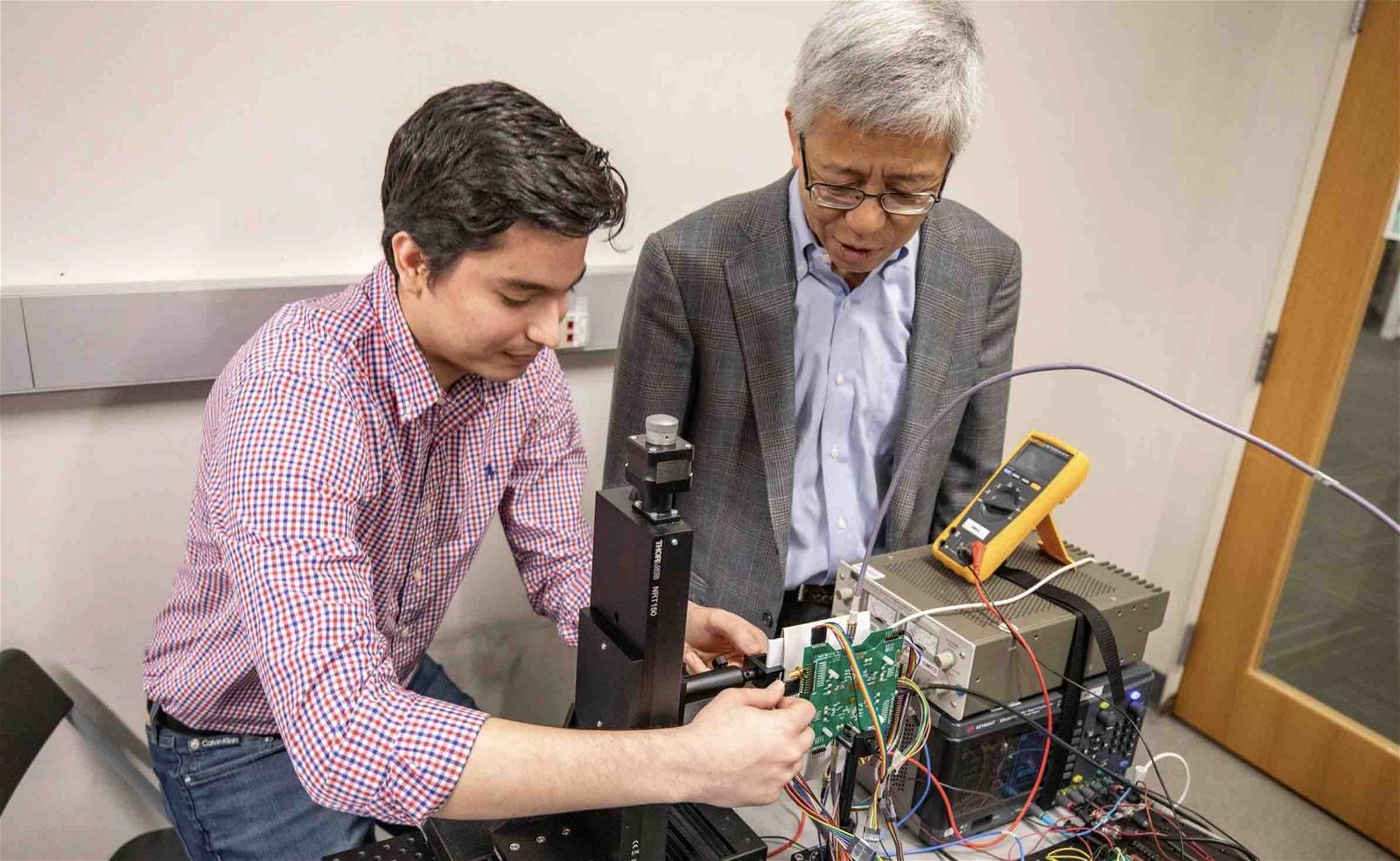After twenty years of research, a team from the University of Texas at Dallas (UTD) says they have perfected a customized imaging chip that can let your mobile device “see” through walls.
Designed using technology similar to package security scanners employed by airline personnel, the chip is small enough to fit into nearly all mobile devices, turning your everyday cell phone into a Superman-inspired X-ray-style scanner.
“This technology is like Superman’s X-ray vision,” said Dr. Kenneth K. O, director of the Texas Analog Center of Excellence (TxACE) and the Texas Instruments Distinguished University Chair in the Erik Jonsson School of Engineering and Computer Science, in a press release announcing the new device.
While the initial version of the chip is intended to help people scan through packages before opening them or even find hidden wires or studs behind a wall, the team behind the chip’s creation says they are also exploring its potential medical applications. They are also exploring uses for firefighters or industrial workers who need to see through smoke, fog, or other obstacles limiting their vision like they were from the planet Krypton.


How Imaging Chip Lets Your Cell Phone See Through Walls
In a research paper published in the journal IEEE Transactions on Terahertz Science and Technology, Dr. O. and his team outline the years of work and engineering breakthroughs that led to the development of their super-powered imaging chip that can effectively see through walls. The team also explained how the technology works, including allaying any concerns that the device may be dangerous.
For example, the chip emits 300-GHz signals in the millimetre-wave band of electromagnetic frequencies. This places it somewhere between microwaves used by airport scanners and the infrared used by IR imaging systems. Signals at this wavelength are invisible to the human eye and are not considered to be harmful.
“We use signals at 200 gigahertz to 400 gigahertz instead of X-rays, [like Superman],” Dr. O. explained, “which can be harmful.”
Similar to RADAR and SONAR systems that use radio and sound waves, respectively, to “view” obstructed objects, and unlike devices that use shadows and reflections to build an approximation of what is on the other side of an obstacle, the waves emitted by the chip can pass through walls or other materials before bouncing off of solid objects on the other side. Sensors on the chip collect these reflected signals and then convert them into a viewable image. Perhaps surprisingly, the researchers note that waves at these scales can create relatively high-definition images, with individual pixels as small as half a millimetre square.
“The pixels, which create images by detecting signals reflected from a target object, have the shape of a 0.5-mm square, about the size of a grain of sand,” said Dr. Wooyeol Choi, assistant professor at Seoul National University and the corresponding author of the latest paper.
Improvements in Resolution and Power Led to Mobile Device-Compatible Chip
In a 2022 study describing an earlier iteration of the imaging chip designed for more industrial applications, the researchers said that a key challenge to making the device operate on a chip small enough to fit in a mobile device had been power usage.
“The key thing about the terahertz imager is making the pixels small and low power,” said Dr. Wooyeol Choi, an assistant professor of electrical and computer engineering at Oklahoma State University and former assistant research professor at UT Dallas, where he first began working on the technology with Dr. O. “You need to integrate a transmitter, receiver and antenna in such a small area.”


Two years later, the team says that removing certain components and minimizing others resulted in a chip small enough to be used in virtually any mobile device, resulting in this latest version of the chip.
“We designed the chip without lenses or optics so that it could fit into a mobile device,” said Dr. Choi.
“It took 15 years of research that improved pixel performance by 100 million times, combined with digital signal processing techniques, to make this imaging demonstration possible,” added Dr. Brian Ginsburg, director of RF/mmW and high-speed research at Texas Instrument’s Kilby Labs. “This disruptive technology shows the potential capability of true THz imaging.”
Although the larger device described in the team’s 2022 research could image objects a few meters away, and the team is currently working on an industrial-level THz scanner that can see objects through obstacles up to 20 meters away, the team says they have restricted the distance of their mobile device imaging chip to just one inch due to security and privacy concerns.
For example, Dr. O explained that if a thief attempted to surreptitiously scan the contents of someone’s purse or travel bag, the perpetrator would need to be so close that the intended victim would almost surely be aware of what they were doing. Still, the researchers do note that a future iteration of the chip that can see through walls may operate up to a distance of five inches.
Potential Applications Include Security, Autonomous Driving and Rescue Workers
Although the chip that can see through walls is not yet available for purchase, the team says it has already targeted several potential uses. For example, the team says a THz scanner could be integrated into autonomous vehicle systems to help them navigate through adverse weather or other hazardous road conditions that limit visibility. In such cases, an application using their scanner could present the driver with the outline of a car or other obstruction that may not be visible through heavy rain or dense fog.
Dr. O also his device and its technology could also be adapted for use in industrial settings where visibility is limited. For example, it could help with non-invasive package inspections or even assist rescue workers or other first responders in life-saving situations.
“The technology allows you to see in vision-impaired environments,” Dr. O explained. “In industrial settings, for example, devices using the microchips could help with packaging inspections for manufacturing process control, monitoring moisture content or seeing through steam. If you are a firefighter, it could help you see through smoke and fire.”
Electrical engineering graduate student Walter Sosa Portillo, who is working with Dr. O, says he is currently investigating potential medical applications for their new scanning chip. As far as why he joined the effort in the first place, Portillo says he thought the idea was simply too “cool” to pass up.
“The first day I came to orientation, they talked about Dr. O’s research,” said Portillo, “and I thought it was really interesting and pretty cool to be able to see through things.”
Christopher Plain is a Science Fiction and Fantasy novelist and Head Science Writer at The Debrief. Follow and connect with him on X, learn about his books at plainfiction.com, or email him directly at christopher@thedebrief.org.

